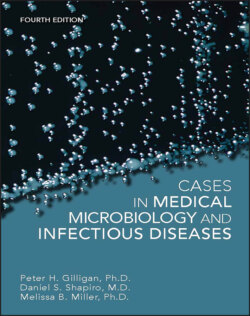Читать книгу Cases in Medical Microbiology and Infectious Diseases - Melissa B. Miller - Страница 60
CASE 8
ОглавлениеThe patient was a 64-year-old retired postal worker with a medical history of extensive facial reconstruction for squamous cell carcinoma of the head and neck. He had a 30-year history of smoking. The patient presented with progressive shortness of breath, a persistent, productive cough, purulent sputum, and fever to 39.0°C 2 days prior to admission.
On physical examination he had a temperature of 37.3°C, respiratory rate of 18 per minute, pulse rate of 103 beats/min, blood pressure of 154/107 mm Hg, and pO2 of 92 mm Hg. Chest auscultation revealed coarse breath sounds at the left lower base with bibasilar fine crackles. He was found to have a left lower lobe infiltrate on chest radiograph. His admission white blood cell count was 10,600/μl with 70% neutrophils, and his hemoglobin was 9.4 g/dl. Sputum Gram stain at admission revealed >25 polymorphonuclear cells and >25 squamous epithelial cells per low-power field. Because of the high numbers of squamous epithelial cells, the specimen was not processed further. Two blood cultures obtained at admission were positive for the organism seen in Fig. 8.1. The Gram stain from the blood culture bottle is shown in Fig. 8.2.
The patient was admitted to the hospital and treated with ceftriaxone intravenously. Upon defervescence, he was discharged on a regimen of oral azithromycin based on the organism’s identification and antimicrobial susceptibility results. Of note: this was the patient’s third episode of this illness in the past month. Isolates from all three episodes belonged to the same serotype, type 23.
Figure 8.1
Figure 8.2
1 1. What disease process was ongoing in this patient? What clinical prediction rules could be applied to this patient in determining whether he should be hospitalized? Why do you think the decision was made to hospitalize him?
2 2. What organism was causing this individual’s infection?
3 3. What other patient populations are at risk for infection with this organism?
4 4. Two different virulence factors produced by the organism infecting this patient are important in disease pathogenesis. What are they, and what role do they have in the pathogenicity of this organism?
5 5. What strategies are available to prevent infections with this organism? Why are preventive strategies becoming of greater importance with this organism?
6 6. How do you explain the patient’s having repeated episodes of infection with the same serotype of this organism? There are at least two and possibly more explanations.
